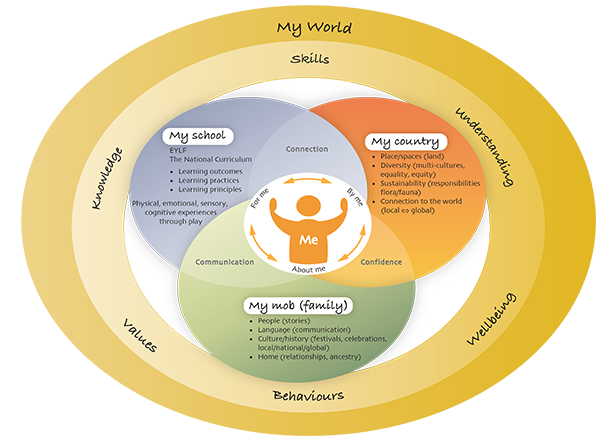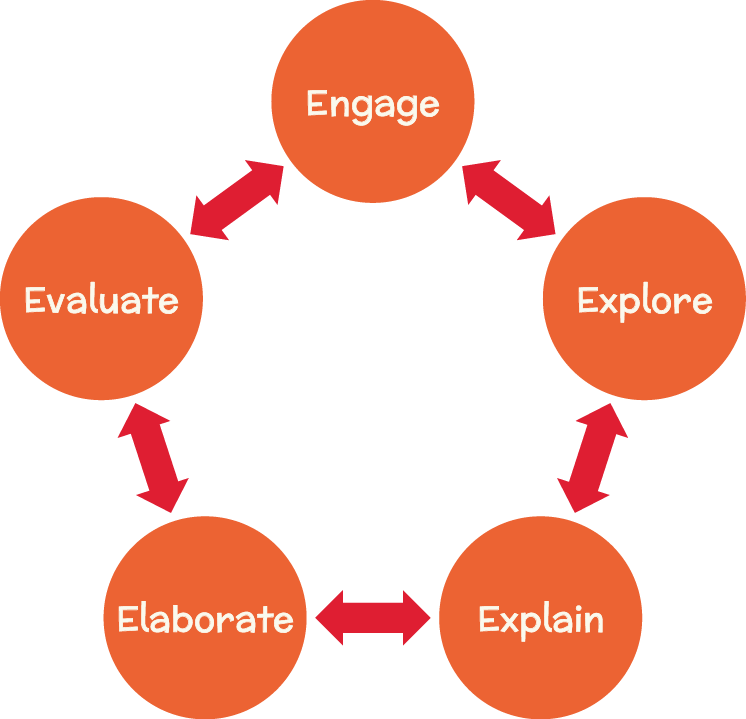F–2 framework
The Little J & Big Cuz F–2 framework positions the Foundation to Year 2 student at the centre of their own world, and emphasises that all ways of learning – formal and informal learning, and Aboriginal peoples and/or Torres Strait Islander peoples’ ways of learning – should ignite a child’s curiosity about their world and support their independence when learning new knowledge and skills to enhance understanding.
Resources by episode
The framework embeds three perspectives on how young children gain independence through these various forms of learning:
For Me: Things I should learn about so that I am more prepared as an individual and/or member of community to participate in my world”
About Me: Things I need to develop and understand about myself, such as physical, social, cognitive and emotional abilities and capabilities’
By Me: Things I play with, think about, talk about, explore, discover and create in my world”
The Little J & Big Cuz F-2 education resource framework draws on and incorporates the educational statements and early childhood objectives evident in three main documents:
- Belonging, Being, Becoming: Early Years Learning Framework, Department of Education and Training, Australian Government
- Learning from Good Practice: Implementing the Early Years Learning Framework for Aboriginal and Torres Strait Islander children, Report 2012 and Resources 2012, Secretariat of National Aboriginal and Islander Child Care (SNAICC)
- Australian Curriculum (Foundation Year–Year 10), v8.3, Australian Curriculum Assessment and Reporting Authority (ACARA)
These statements and objectives promote various ‘ways of knowing and doing’ evidenced through the personal and social concepts - My Country, My Mob, and My School.
The Little J & Big Cuz F-2 framework acknowledges that once at school, Aboriginal students and/or Torres Strait Islander students, and all students, learn more effectively when they are given opportunities to learn and play ‘on Country’ and ‘off Country’ and the content they engage with is respectful of the contributions of Aboriginal peoples’ and/or Torres Strait Islander peoples’ histories, cultures, literature, arts, sciences, technologies and languages.
Little J & Big Cuz F-2 Framework: Ways of knowing and doing

MY COUNTRY
- Exploring and caring for the land/sea, flora and fauna
- Respecting protocols about travelling on different Countries, taking from and giving back to Country
- Speaking about Country to others – understanding and knowing the stories of the past, and recognising the wisdom of the Elders who can pass these stories on through storytelling, art, dance, and music.

MY MOB
- Learning and respecting Culture
- Speaking, reading and writing in Language
- Recognising my responsibilities and contributing to my Community

MY SCHOOL
- Learning areas’ knowledge, understanding and skills
- Year level/band achievement standards
- Ways of working: Inquiry processes within the learning areas, affective domains, general capabilities, and cross curriculum priorities, particularly the Aboriginal and Torres Strait Islander histories and cultures priority
- Language: First peoples’ and English
The Little J & Big Cuz F-2 framework promotes that all students (Aboriginal students Torres Strait Islander students, and non-Indigenous students) at all years of schooling require opportunities to engage with Aboriginal and/or Torres Strait Islander knowledge, understanding and skills as an integral part of learning across the curriculum.
Curriculum
The Little J & Big Cuz F-2 education resource adopts a multidisciplinary integration approach where themes related to the episode narrative are examined through the lenses of two Australian Curriculum (v8.3) learning areas, such as History and Science, or English and Technologies. Each module of 5E teaching and learning activities explicitly address the intent of each learning areas’ knowledge, understanding and skills as identified in the relevant curriculum learning area’s content descriptions.
For English, Science, Mathematics, and HASS_ History and Geography there are separate teaching and learning activities developed for Foundation Year, Year 1, and Year 2; for Health and Physical Education there are learning activities specified for Foundation Year and Years 1-2; and for The Arts, and Technologies, there are three teaching and learning activities labelled F-2 for each inquiry stage. There is a list of key terms associated with the 5E activities at the end of each year level module. Also available is a full list of references and resources linked to the teaching and learning activities.
Educators should review the content of the episodes’ to select which activities are best for the age level, capabilities, and interests of their students. The education resources hyperlink to third-party websites which build knowledge and suggest further learning opportunities. At times, these activities rely on students having access to mobile technologies. Educators should determine which pedagogical strategies will be more effective given the context of their school. The third-party web links have been checked as appropriate for educators, and some are appropriate for students. It is important that educators review all content and activities before introducing it to students.
All teaching and learning activities have been reviewed by Aboriginal educators and/or Torres Strait Islander educators and these experts have provided advice on the protocols and procedures of introducing some content to Aboriginal and /or Torres Strait Islander students.
Pedagogy
It is envisioned that after viewing a Little J & Big Cuz episode, students will pose and respond to questions that enhance their comprehension of the story and broader screen literacies. These questions and conversations should ignite further thinking about the themes, allowing teachers to springboard into further exploration and teaching of explicit knowledge and skills learning within each learning area.
Effective pedagogies for teaching Aboriginal children and/or Torres Strait Islander children promote active, visual, aural, oral and kinaesthetic learning incorporating students’ prior knowledge about learning ‘on Country’, First language/s, and their community protocols. The ‘8 Aboriginal Ways of Learning’ is an important guide to use when selecting and introducing learning activities with Aboriginal children and/or Torres Strait Islander children.
5Es Inquiry approach:
The Little J & Big Cuz F-2 education resource adopts a 5Es Inquiry approach: Engage, Explore, Explain, Elaborate, and Evaluate. There are learning area inquiry questions for each year level that guide a 5Es inquiry. The learning activities are written to address the main thinking processes associated with each of the 5E stages and to reflect the intent of selected learning area content descriptions.
In a sequential 5E approach, each of the 5E stages rely on the completion of the previous stages. For this learning resource, each of the learning activities can be used as sequential or as independent entities that can stand alone. Thus, each teaching and learning activity contains elements of engagement, development, and realisation and/or application.
“© Australian Curriculum, Assessment and Reporting Authority (ACARA) 2010 to present, unless otherwise indicated. This material was downloaded from the Australian Curriculum website (Website) (accessed [insert date]) and [was][was not] modified. The material is licensed under CC BY 4.0. Version updates are tracked on the Curriculum version history page of the Australian Curriculum website.
ACARA does not endorse any product that uses the Australian Curriculum or make any representations as to the quality of such products. Any product that uses material published on this website should not be taken to be affiliated with ACARA or have the sponsorship or approval of ACARA. It is up to each person to make their own assessment of the product, taking into account matters including, but not limited to, the version number and the degree to which the materials align with the content descriptions (where relevant). Where there is a claim of alignment, it is important to check that the materials align with the content descriptions (endorsed by all education Ministers), not the elaborations (examples provided by ACARA).”
“It is important to check the frequency with which the platform or app is updated and, if the platform or app allows users to download the Australian Curriculum to their portable device, how often and in what circumstances the user’s device synchronises with the platform


